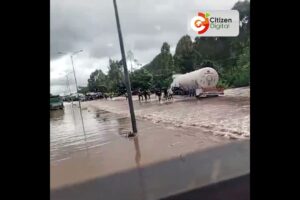
Decarbonizing our power production is vitally important if we want to curtail climate change, but there are some major logistical issues we’re going to have to overcome before we can do that. In this episode of Crash Course Climate and Energy, we’ll take a look at the challenges we face when creating, distributing, and storing electricity from renewable sources.
Chapters:
Introduction: Storing Carbon-Free Electricity 00:00
Electricity As An Energy Carrier 1:10
The Electric Grid 2:10
Electricity Supply & The Duck Curve 3:30
Electrochemical Storage of Electricity 6:20
Chemical Storage of Electricity 7:28
Mechanical Storage of Electricity 8:20
Thermal Storage of Electricity 8:57
Transmitting Carbon-Free Electricity 9:52
Review & Credits 11:28
Transcript: https://docs.google.com/document/d/1ak1uYh9R1IsE6U9g79sJtBDOyk9mMjyDtBlyo-sWTfU/edit?usp=sharing
Sources:
https://docs.google.com/document/d/1rRJ-L9TLNfPwPfzn3LdjDEw-wHtThwTfDUe2rDtFXQQ/edit?usp=sharing
Watch our videos and review your learning with the Crash Course App!
Download here for Apple Devices: https://apple.co/3d4eyZo
Download here for Android Devices: https://bit.ly/2SrDulJ
Crash Course is on Patreon! You can support us directly by signing up at http://www.patreon.com/crashcourse
Thanks to the following patrons for their generous monthly contributions that help keep Crash Course free for everyone forever:
Katie, Austin Zielman, Tori Thomas, Justin Snyder, DL Singfield, Amelia Ryczek, Ken Davidian, Stephen Akuffo, Toni Miles, Steve Segreto, Kyle & Katherine Callahan, Laurel Stevens, Stacey Gillespie (Stacey J), Burt Humburg, Allyson Martin, Aziz Y, DAVID MORTON HUDSON, Perry Joyce, Scott Harrison, Mark & Susan Billian, Alan Bridgeman, Rachel Creager, Breanna Bosso, Matt Curls, Jennifer Killen, Jon Allen, Sarah & Nathan Catchings, team dorsey, Trevin Beattie, Eric Koslow, Jennifer Dineen, Indija-ka Siriwardena, Jason Rostoker, Siobhán, Ken Penttinen, Nathan Taylor, Les Aker, William McGraw, ClareG, Rizwan Kassim, Constance Urist, Alex Hackman, Pineapples of Solidarity, Katie Dean, Thomas Greinert, Wai Jack Sin, Ian Dundore, Justin, Mark, Caleb Weeks
__
Want to find Crash Course elsewhere on the internet?
Facebook – http://www.facebook.com/YouTubeCrashCourse
Twitter – http://www.twitter.com/TheCrashCourse
Instagram – https://www.instagram.com/thecrashcourse/
CC Kids: http://www.youtube.com/crashcoursekids
source







Another way to balance supply and demand on the electrical grid is to make the grid a little bit smarter so that appliances that need electricity, but can wait for it, can be told to wait. For example, your electric water heater needs some electricity throughout the day, but it doesn't need it on demand. There is a pilot project in Vermont where water heaters request a packet of energy when the water temperature drops. If there is plenty of capacity, they get it. If demand for power is high, they are asked to wait a bit.
The same idea works even better with electric cars. They can consume the excess capacity when there is plenty of wind or solar, and they could even supply power to the grid during peak demand. Cars are parked most of the time. The grid could use them as a large distributed energy storage facility.
SMR/MSR tech is so heavily contested now in the US, that corrosion and 'waste' storage solutions are now being copyrighted as a standard operating procedure. Perhaps TerraPower and Bill Gates can help educate the innocently ignorant into gradually graduating fossil fuels.
Solar panels in Sahara desert can be used for desalination and production of Methane for transportation with LNG to the rest of the world. No need for the wires – ships can transmit energy better. Downside – requires stability in the region and huge upfront costs. Shame middle east monarchies are wasting their oil money on weird projects rather than building infrastructure for such energy production
I'm not an engineer, but would Kinetik energy storage work? Just turning a massive concert slab covered in copper. I know they do it at the technical Uni Munich for big experiments.
Space consumption and environmental damage from mining ALWAYS need to be compared to the space and environmental (and political violence) issues of fossil fuels. Another thing to consider is that the rare minerals required to make solar panels, batteries, etc are largely recyclable, so at some point the need for mining will level off, as it becomes easier to just reclaim the materials from worn-out batteries and solar panels. This is NOT true of fossil fuel, which needs to be endlessly mined/pumped for as long as we keep using it. Which cannot be forever, because we’ll eventually run out.
What about using sand to store heat? Very efficient and you avoid the corrosive issue of salt.
Connecting grids is an important step, but I think you should have mentioned the difficulties of doing this. Especially over vast distances as you suggested. Both logistically as well as just the basic physics of it.
Otherwise, great video and I'm really enjoying the series so far.
This episode is the most significant part of the climate & energy problem, because it's not affordable. Energy savings that are also cost savings motivate everyone automatically. Engineering and economics work together, no need for government or marches through the streets to change behavior. The cost of storage is ginormous, full stop. "Electrify everything to de-carbonize everything" isn't going to happen without a storage breakthrough. All the "carbon neutral by 20xx" claims are nothing but empty promises/marketing baloney; there just isn't enough money. It's like fusion power, always 25 years away.
Much as you were trying to provide a diverse view on how energy storage can be done, I feel that not enough merit is being given to the big elephant in the room – the sustainable production of batteries.
You can no longer simply write them off by saying that they are 'bad' because of their 'mining operations'.
The battery eco system has gotten to such a scale and momentum that we should learn instead, to be informed of it's drawbacks and how we can help to deal with them… rather than to try and treat them, and other ways of energy storage as equals. They are NOT equals anymore. Huge corporations in China and Tesla have already set up in such a way that hundreds of gigawatts and even terawatts of battery storage would be scaled up in just the next few years.
Many research has already shown that batteries can be recycled. Tesla co-founder JB Straubel has poured billions into a recycling facility. These will help alleviate the mining situation as the transition tappers and the old batteries start to come in.
Action should be taken now and people need to be informed. The rest of your suggested methods, tbh, are just cosmetics. Even when combined, they will not make up 5% of the amount of batteries in storage power that will be flooding the market.
But what about the big spinny things for storing electricity?
I'll wait for the next video! Have a graceful day ❤ GOD loves u 🙂
Surprised that you didn´t talk about flywheels for storage, they are a neat idea in my opinion, and can be an option where mechanical storage using water isn´t possible.
Can we talk about green hydrogen please 🙏🏻
We could just use nuclear energy….
The government should start a program to get solar panels on every roof.
I love this series so much.
My only complaint is that we need to get you a new suite of synth sounds for the screen transitions. 🙂
Liquid Metal Batteries (Ambri) for grid-scale storage… modular & no rare metals.
There are also carbon dioxide battery storage, sand batteries, heat pumps. In Finland, data banks draw off heat from the servers using heat pumps with the heat being used for district heating. Renewable energy has so many options that a local energy strategy using the most appropriate geo-physical assets can be devised & deployed. Japan is using snow to generate electricity!
And there is also community storage… excess community energy is stored locally (no private battery storage) for a nominal fee.
There are so many options now.
Smart buildings. Could send a signal to turn on AC units when renewables are peaking the grid, thermal storage 🙂
Mass Electric cars could balance the grid using the top 20% of thier charge cycle.
Ethanol.
I'm from Indy! Any suggestions or recommendations on localized actions?
i love crashcorse
Pumped storage is a great way to manage the problem of storing electricity generated at times when it is not needed.
Dinorwig power station in Wales (also known as the Electric Mountain) is such a system, which can spin up to 1800MW from nothing in just 16 seconds, and run for 6 hours at a time. It isn't perfect, it's about 75% efficient, but that's still a much better bet than having a load of fossil fuel stations running to meet the same demand.
I've seen some suggestions for low-tech thermal storage that seem like they would be reasonably efficient and robust. Things like a big mass of red-hot bricks in a big hole. Is there a catch with those? Are they just a lot less efficient than I think?